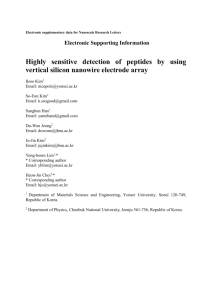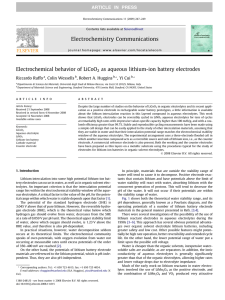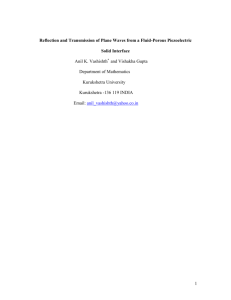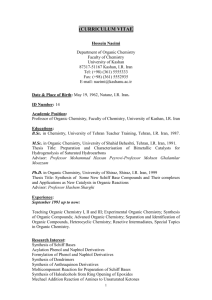water
advertisement
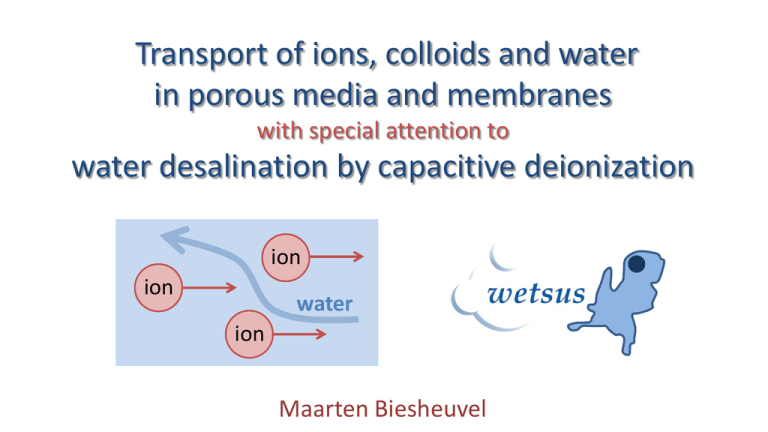
Transport of ions, colloids and water in porous media and membranes with special attention to water desalination by capacitive deionization ion ion water ion Maarten Biesheuvel Overview • • • • Capacitive Deionization (CDI) Porous electrode theory Modeling ion electrokinetics (combined flow of water, ions, colloids) Sedimentation of colloidal particles 2 Carbon Electrode + + Porous Current Collector - _ Current Collector Capacitive Deionization + + + + + cations Porous Carbon Electrode + + electrical current Electrical Feed Water current Freshwater Porous Carbon Electrode _ + + - _ + + + + + Feed Water- Freshwater - -- - - + + + Current Collector Current Collector + cations - anions cations anions - anions cations + + - - - + - Curren - Curre cations Porous Car - - Porous Car Porous Carbon Electrode + Porous Carbon Electrode electrical current _ + - Feed Water V VVcell cell Current Collector Vcell + + _ anions - 3 Membrane Capacitive Deionization with ion-exchange membranes 4 Membrane Capacitive Deionization 5 6 CDI testing 7 Water out What does CDI look like? current collector carbon electrode cation exchange membrane Water in anion exchange membrane carbon electrode current collector 8 Ion-exchange membrane Carbon electrode Carbon Electrode Carbon electrode Graphite rod CDI designs using cylinders (wires) Electrode composition: 90 wt % active carbon 10 wt % polymeric binder 9 10 2 11 2 Transport in porous electrodes electron-conducting matrix 12 2 Transport in porous electrodes “RC Transmission Line Theory”, or “De Levie Theory” 13 2 Bob (Robert) de Levie ISE, Prague, 2012 14 RC transmission line theory pore pore pore is potential in aqueous pore relative to conducting matrix (metal, carbon) 15 2 Generalized porous electrode theory Prof. Martin Bazant MIT, USA 16 2 Generalized porous electrode theory From abstract: Todd Squires 17 2 Transport in porous electrodes Transport equation in mAcropores ci JNP,i ji,mAmi t “Electrical double layer” model in micropores St carbon matrix diffuse layer d ji,mAmi (x) JNP,i ,ci,mA V ,ci,mi JNP,i Di ci zici 18 2 Porous electrode transport theory + e- + - + + - + Brackish water Potable water - + + - + + 19 Potable water Porous electrode transport theory - + - + - + + - Ion transport in the mAcropores + - Brackish water + + + Ion adsorption in the micropores 20 21 Including acid/base reactions In NP-transport modeling in porous media • Water not just contains a salt like NaCl which can be assumed fully dissociated • Instead, more realistically there are many ions that can undergo acid/base reactions, such as NH3, NH4+, HCO3• Of special relevance the reactions with and between H+ and OH• All these species must be considered ! F.G. Helfferich (1922-2005) 22 Helfferich-approach ci JNP,i Ri t RA RB RC JNP,i Di ci zici AB C RA k [ A][B] k [C ] [ A][B] Ki [C ] CO H K HCO 2 3 i 3 F.G. Helfferich 23 Advantages Helfferich-approach • By addition of balances, for each “group” such as CO2/HCO3-/CO32-, only one balance per group remains (expressed in one chosen “master species”) • All dummy parameters R disappear ! • Very elegant now to include electrochemical reactions at electrodes, or evaporation F.G. Helfferich 24 Steady-state diffusion of “acid/base ions” 0.350 4 H2CO3 0.300 Na+ H+ OH- ion flux bulk Cl- Ion flux CO32- fr current by OH curr +2 flux H2CO3 flux CO3^2- 1 flux OH 0 OH- -1 HCO3- -2 CO32- -3 0.250 “2H+ +2e- H2 (g)” HCO3 fr current by OH curr +4 flux HCO3 2 current_by_OH/total_current H2CO3 - fr current by OH curr +3 3 0.200 increas current 0.150 0.100 0.050 0.000 -4 0 0.1 0.2 0.3 0.4 0.5 0.6 0.7 0.8 0.9 1 0 0.1 0.2 0.3 x-coordinate position It’s not the proton that flows, and it is not the source of the formed H2-gas !!! 25 Current-induced membrane discharge water in membrane pores membrane discharge SDL: stagnant diffusion layer Membrane: water-filled structure with very high concentration of fixed charge, such as RH+, e.g. 5 M 26 Current-induced membrane discharge charge parameter RH RH R 27 Ion electrokinetics incl. flow of water ion ion water ion • Same approach for ions as for colloids, protein and larger particles • The ion (with its hydrated water molecules) is a dispersed particle • Water is the continuum fluidum in between – described very differently from the ions !! • Extension of two-fluid model to “colloidal regime” 28 Two-fluid model ion ion water ion 29 Two-fluid model for colloidal mixtures vi v water Di i i lnci zi excess Vi P total migh total = Phydr - osm PNernst-Planck “Two fluid Navier-Stokes Equation” ci total 2 P waterg v water vi v water i Di P hydr avgg 2 v water elecE 30 Paradox in sedimentation (Theoretical) physicist: at equilibrium, the gravitational force a colloidal particle feels is its mass density minus that of the solvent (the liquid in between)” (Chemical) engineer: in a mixed system, a particle feels the average, suspension density (*) (*): and for non-colloidal (larger) particles always 31 Sedimentation of colloidal particles Solvent/supernatant • Three types of colloidal particles (< 1 micron size) with different colors • All heavier than the solvent • Purple is mixture • Not a “solid” sediment that is formed 32 Thank you for your attention !
